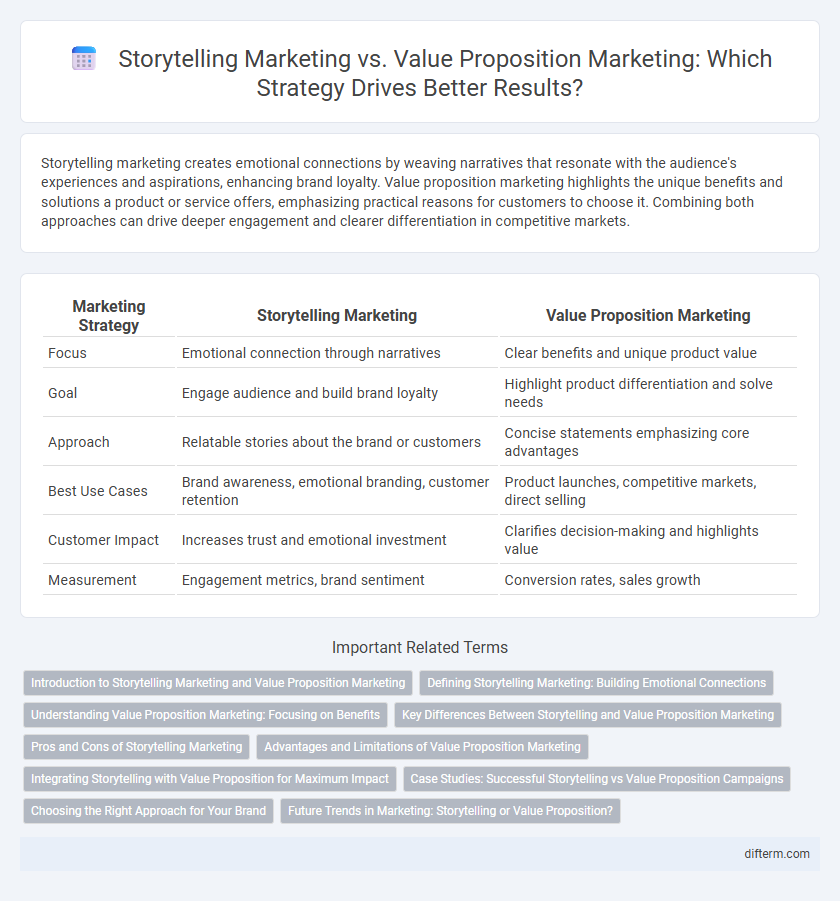Storytelling marketing creates emotional connections by weaving narratives that resonate with the audience's experiences and aspirations, enhancing brand loyalty. Value proposition marketing highlights the unique benefits and solutions a product or service offers, emphasizing practical reasons for customers to choose it. Combining both approaches can drive deeper engagement and clearer differentiation in competitive markets.
Table of Comparison
| Marketing Strategy | Storytelling Marketing | Value Proposition Marketing |
|---|---|---|
| Focus | Emotional connection through narratives | Clear benefits and unique product value |
| Goal | Engage audience and build brand loyalty | Highlight product differentiation and solve needs |
| Approach | Relatable stories about the brand or customers | Concise statements emphasizing core advantages |
| Best Use Cases | Brand awareness, emotional branding, customer retention | Product launches, competitive markets, direct selling |
| Customer Impact | Increases trust and emotional investment | Clarifies decision-making and highlights value |
| Measurement | Engagement metrics, brand sentiment | Conversion rates, sales growth |
Introduction to Storytelling Marketing and Value Proposition Marketing
Storytelling marketing creates emotional connections by crafting narratives that resonate with the target audience's experiences and values, enhancing brand loyalty and engagement. Value proposition marketing highlights the unique benefits and solutions a product or service offers, clearly communicating why it is superior to competitors. Combining both approaches can effectively convey a brand's identity while emphasizing its distinct market advantages.
Defining Storytelling Marketing: Building Emotional Connections
Storytelling marketing focuses on creating emotional connections by weaving narratives that resonate with audiences' experiences and values, enhancing brand loyalty. Unlike value proposition marketing, which emphasizes product benefits and features, storytelling marketing engages customers through relatable characters and compelling plots. This strategy leverages emotional triggers to foster deeper engagement and lasting relationships with brands.
Understanding Value Proposition Marketing: Focusing on Benefits
Value proposition marketing centers on clearly communicating the unique benefits and solutions a product or service offers to meet customer needs. Unlike storytelling marketing, which uses narratives to build emotional connections, value proposition marketing delivers concise, practical reasons for consumers to choose a brand based on specific advantages. Emphasizing tangible benefits enhances customer decision-making by highlighting how a product directly solves problems or improves their lives.
Key Differences Between Storytelling and Value Proposition Marketing
Storytelling marketing emphasizes emotional engagement by weaving narratives that resonate with the audience's experiences and aspirations, creating memorable brand connections. Value proposition marketing focuses on clearly communicating the unique benefits and solutions a product or service offers, highlighting tangible outcomes and competitive advantages. The key difference lies in storytelling's ability to build brand loyalty through relatable stories, whereas value proposition marketing drives decision-making through clear, concise claims of value.
Pros and Cons of Storytelling Marketing
Storytelling marketing creates emotional connections by embedding brand messages within compelling narratives, enhancing audience engagement and recall. However, it can be time-consuming and may dilute the core value proposition if the story overshadows key product benefits. Brands risk inconsistency and reduced clarity when stories prioritize entertainment over clear communication of unique selling points.
Advantages and Limitations of Value Proposition Marketing
Value proposition marketing clearly communicates a brand's unique benefits, making it easier to differentiate in competitive markets and attract targeted customers. This approach improves conversion rates by addressing specific customer needs with focused messaging, enhancing perceived value. However, it may lack emotional engagement and narrative depth, which can limit long-term brand loyalty compared to storytelling marketing.
Integrating Storytelling with Value Proposition for Maximum Impact
Integrating storytelling with value proposition marketing enhances customer engagement by emotionally connecting the audience while clearly communicating the unique benefits of a product or service. Storytelling creates memorable narratives that highlight real-life applications of the value proposition, making the brand message more relatable and persuasive. Combining these strategies drives stronger brand loyalty and higher conversion rates by addressing both emotional resonance and rational decision-making factors.
Case Studies: Successful Storytelling vs Value Proposition Campaigns
Case studies reveal storytelling marketing campaigns like Nike's "Just Do It" successfully create emotional connections that drive brand loyalty by weaving customer experiences into compelling narratives. In contrast, value proposition marketing campaigns such as Apple's focus on clear, concise communication of product benefits, emphasizing innovation and quality to differentiate in competitive markets. Data indicates storytelling increases engagement rates by up to 55%, while strong value propositions boost conversion rates by approximately 30%, showcasing distinct advantages of each approach in targeted marketing strategies.
Choosing the Right Approach for Your Brand
Selecting the right marketing approach depends on your brand's goals and audience preferences; storytelling marketing creates emotional connections through narratives, enhancing brand loyalty and engagement. Value proposition marketing clearly communicates the unique benefits and solutions your product or service offers, driving immediate customer action and differentiation. Analyzing customer behavior and market trends helps determine whether a compelling story or a concise value proposition will most effectively resonate with your target market.
Future Trends in Marketing: Storytelling or Value Proposition?
Future trends in marketing reveal a growing emphasis on storytelling marketing, leveraging emotional engagement and authentic narratives to build brand loyalty and consumer trust. Meanwhile, value proposition marketing continues to prioritize clear, concise communication of unique product benefits and competitive advantages for customer decision-making. Combining storytelling with a strong value proposition is predicted to create more compelling and differentiated brand experiences that resonate in increasingly saturated markets.
storytelling marketing vs value proposition marketing Infographic

 difterm.com
difterm.com